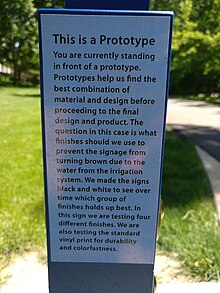
Back Prototipe Afrikaans نموذج مبدئي Arabic Прототип Bulgarian Prototip BS Prototip Catalan Prototyp Czech Prototype Danish Prototyp (Technik) German Πρωτότυπο Greek Prototipo Esperanto


A prototype is an early sample, model, or release of a product built to test a concept or process.[1] It is a term used in a variety of contexts, including semantics, design, electronics, and software programming. A prototype is generally used to evaluate a new design to enhance precision by system analysts and users.[2][3] Prototyping serves to provide specifications for a real, working system rather than a theoretical one.[4] Physical prototyping has a long history, and paper prototyping and virtual prototyping now extensively complement it. In some design workflow models, creating a prototype (a process sometimes called materialization) is the step between the formalization and the evaluation of an idea.[5]
A prototype can also mean a typical example of something such as in the use of the derivation 'prototypical'.[6] This is a useful term in identifying objects, behaviours and concepts which are considered the accepted norm and is analogous with terms such as stereotypes and archetypes.
The word prototype derives from the Greek πρωτότυπον prototypon, "primitive form", neutral of πρωτότυπος prototypos, "original, primitive", from πρῶτος protos, "first" and τύπος typos, "impression" (originally in the sense of a mark left by a blow, then by a stamp struck by a die (note "typewriter"); by implication a scar or mark; by analogy a shape i.e. a statue, (figuratively) style, or resemblance; a model for imitation or illustrative example—note "typical").[1][7][8]
- ^ a b Blackwell, A. H.; Manar, E., eds. (2015). "Prototype". UXL Encyclopedia of Science (3rd ed.). Retrieved 13 July 2015.
- ^ Wragg, David W. (1973). A Dictionary of Aviation (first ed.). Osprey. p. 216. ISBN 9780850451634.
- ^ Gero, John S. (1990-12-15). "Design Prototypes: A Knowledge Representation Schema for Design". AI Magazine. 11 (4): 26. ISSN 0738-4602.
- ^ "Prototyping Definition". PC Magazine. Archived from the original on 2012-10-15. Retrieved 2012-05-03.
- ^ Marcelo M. Soares; Francesco Rebelo (15 August 2012). Advances in Usability Evaluation. CRC Press. p. 482. ISBN 978-1-4398-7025-9.
- ^ "prototypical (adjective) definition and synonyms | Macmillan Dictionary". www.macmillandictionary.com. Retrieved 2019-12-15.
- ^ Harper, Douglas. "prototype (n.)". Online Etymology Dictionary.
- ^ "Strong's Concordance". strongsconcordance.org. Retrieved 2022-08-07.